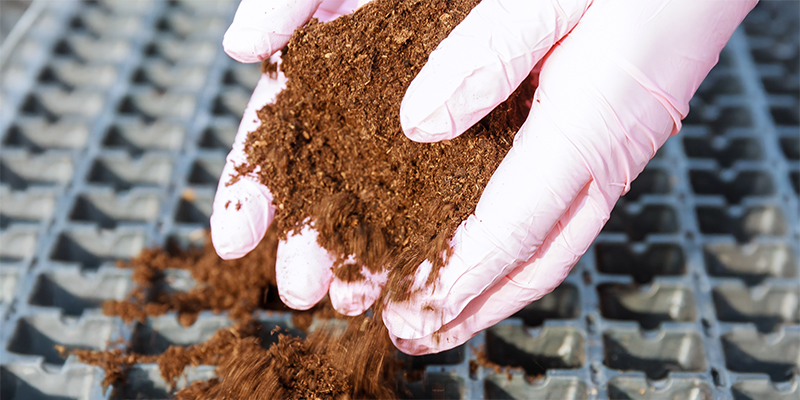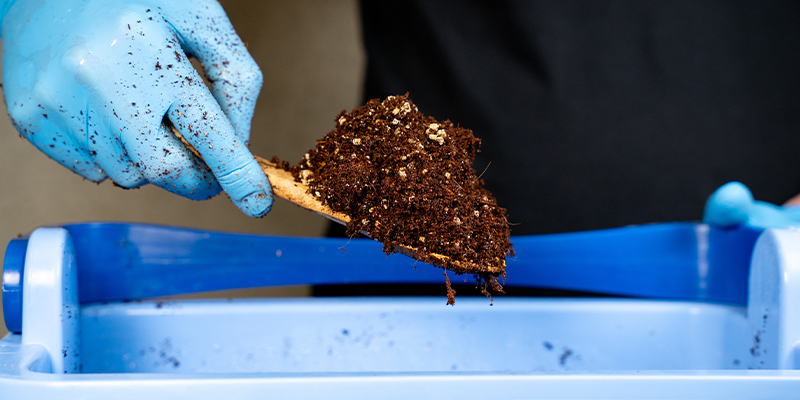Everything you need to know about growing cannabis in coco coir

Perfect for everything from mixing with soil to using in a hydroponic setup, coco coir can be a fantastic substrate for cultivating cannabis plants. Read all about how to do it below.
Coco coir is an inert medium that can be used to grow cannabis in a range of different settings. While its proper usage requires some mastery, it can be incredibly beneficial for cannabis plants—if you’re willing to put the effort in.
Here we’re looking at how to grow cannabis with coco coir, whether it’s in conjunction with soil, alone, or in a hydroponic setup.
What is coco coir?

Coco coir is a natural, fibrous material that comes from coconut husks. Once seen as an agricultural byproduct, it has become a staple in horticulture due to its ability to support vigorous plant growth. To produce coco coir, manufacturers separate the coarse fibres from the husk, soak them in water to break them down (known as “retting”), then process them into different forms suitable for gardening and hydroponics.
Many cannabis growers prefer coco coir because it is versatile and sustainable, making it a great alternative to traditional soil. What’s more, it can be mixed with other substrates to enhance moisture retention and generally improve the growing habitat for your plants.
Why is coco coir popular among cannabis growers?
Coco coir is well-loved because it retains moisture while still providing excellent aeration. If you didn’t already know, this is key for healthy cannabis plants. Traditional soil can compact over time, restricting root growth. Coco coir, on the other hand, remains loose and well-draining. This allows roots to access oxygen more easily.
Since coco coir is a renewable resource and a byproduct, it also offers an environmentally friendly alternative to peat moss (another popular soil alternative). What’s more, it naturally resists pests and pathogens, reducing the risk of soil-borne diseases and making it easier to cultivate healthy cannabis plants.
What are the downsides to growing cannabis in coco coir?

While popular and effective if used properly, coco coir is not the most straightforward growing medium. For this reason, beginners might prefer to stick to a high-quality soil mix instead. Here are the possible drawbacks of using coco:
- Requires constant nutrient management: Unlike soil, which naturally contains nutrients, coco coir is an inert medium, meaning it provides no nutritional value to plants. Growers must maintain a strict and consistent feeding schedule to ensure plants receive the necessary macronutrients and micronutrients. Without proper supplementation, nutrient deficiencies can develop quickly.
- pH fluctuations: The ideal pH range for cannabis in coco coir is between 5.8 and 6.2, but maintaining this range requires regular pH testing and adjustments. If the pH drifts too high or too low, plants may experience nutrient lockout, which prevents them from absorbing essential minerals.
- Not as beginner-friendly as soil: Soil is more forgiving when it comes to nutrient imbalances, pH fluctuations, and watering inconsistencies. Coco coir requires a more hands-on approach, making it slightly more challenging for beginners who are not accustomed to managing hydroponic-style nutrient feeding and pH control.
- Salt buildup: Many commercial coco coir products contain excess salts, which can lead to nutrient toxicity if not properly rinsed and buffered before use. Growers must regularly flush the medium to remove accumulated salts and maintain efficient nutrient absorption.
Some of these drawbacks can be managed by combining coco coir with soil to get the best of both worlds and mitigate the worst of each. Mixing coco coir with perlite or another aerating substrate can also help maintain an optimal balance between water retention and oxygen availability.
Types of coco coir

Coco coir comes in three main forms, each with distinct characteristics that influence how growers use it:
- Coco bricks: Coco bricks are available in a variety of sizes. They need to be soaked, rinsed, and dried before use, unless you’ve specifically bought a buffered and dried brick from the store. Once the brick is dry, you can mix it into your soil—or with perlite if you’re growing hydroponically. Just remember to buy high-quality bricks; poorly made bricks can contain a lot of salt, which won’t be good for your plants, and can be really hard to crumble and mix when preparing your medium.
- Pre-mixed coco blends: Pre-mixed coco blends can be bought from a garden centre just like regular soil. They usually contain a mix of coco and either perlite, clay pebbles, or both. This is a great option if you don’t have the time or space to buy entire bricks and soak, rinse, and dry them at home. As always, opt for a high-quality mix. Your plants will thank you in the end.
- Jiffy pellets: Jiffy pellets are small discs of coco coir. They are widely used to start seedlings, as they help seedlings develop strong root systems quickly. Best of all, once the seedlings are ready and well-rooted, they can be transplanted into any other grow medium.
Preparing coco coir for cannabis cultivation

Proper preparation of coco coir ensures a healthy start for cannabis plants. Growers must rinse and buffer raw coco coir to remove residual salts that can harm plants.
Steps to prepare coco coir
- Rehydrate: If using compressed coco coir bricks, soak them in water until they expand into a fluffy, usable medium. This process typically takes a few hours, depending on the size of the brick and the amount of water used.
- Rinse thoroughly: Flush the coco coir with fresh water to remove excess salts. Skipping this step can lead to nutrient imbalances that stunt plant growth.
- Buffer: Soak the rinsed coco coir in a calcium-magnesium (Cal-Mag) solution for 12–24 hours. This prevents deficiencies by preloading the medium with essential nutrients.
- Drain and dry: Once buffered, drain the excess solution, and let the coco coir reach a slightly moist state before using it as a growing medium.
How to use coco coir as a potting medium

Coco coir works well as a standalone potting medium or when mixed with other materials. Many growers prefer to mix it with perlite in a 70:30 ratio to improve aeration and drainage.
When filling pots with coco coir, avoid compacting the material too much, as this restricts root growth and reduces oxygen availability. Once the pots are filled, plant cannabis seedlings or clones directly into the medium. Water immediately after planting to help the roots establish themselves quickly.
How to use coco coir with hydroponics
Coco coir also works well in hydroponic systems, either as a standalone medium or combined with other substrates like clay pellets. In hydroponic setups, coco coir must stay consistently moist but not waterlogged. Drip irrigation or a flood-and-drain system ensures plants receive the right amount of water and nutrients.
Best nutrients and feeding schedule for cannabis in coco

As mentioned, coco coir is inert, so it does not provide any natural nutrients to cannabis plants. To ensure healthy growth, growers must supply all essential macronutrients and micronutrients through a well-balanced feeding regimen.
The three primary macronutrients—nitrogen (N), phosphorus (P), and potassium (K)—are vital for different stages of plant development. Nitrogen supports leafy growth during the vegetative stage, phosphorus promotes strong root development and flowering, while potassium enhances overall plant health and resistance to stress.
In addition to these macronutrients, calcium (Ca) and magnesium (Mg) are particularly important in coco coir, as the medium tends to bind these elements, making them less available to plants. Without supplementation, calcium and magnesium deficiencies can quickly develop, leading to weak stems, poor root growth, and nutrient lockout.
Essential micronutrients such as iron, zinc, boron, manganese, and copper also play crucial roles in metabolic functions and enzyme activity. These nutrients can be provided in various forms, including liquid nutrient solutions, water-soluble powders, and slow-release granules.
Liquid fertilisers are the most commonly used for hydroponic-style feeding with coco coir, as they provide immediate availability, while powdered nutrients offer flexibility for custom formulations. Slow-release fertilisers, though less common, can be useful when mixing coco coir with soil for a more forgiving and low-maintenance approach.
Sample nutrient schedule
A typical feeding schedule for cannabis in coco coir looks like this:
- Seedling stage: Low-strength nutrient solution (EC—electrical conductivity—0.6–0.8)
- Vegetative stage: Gradually increase nutrients (EC 1.2–1.6)
- Flowering stage: Higher nutrient concentrations (EC 1.8–2.2), with an emphasis on phosphorus and potassium
Watering and pH management in coco coir

Cannabis grown in coco coir needs a precise watering schedule. Unlike soil, which holds nutrients longer, coco coir requires frequent watering to maintain optimal nutrient availability. Water daily, ensuring 10–20% runoff to prevent salt buildup.
Maintaining the correct pH range is also crucial. The ideal pH level for cannabis in coco coir falls between 5.8 and 6.2. Regular testing and adjustments with pH up/down solutions ensure plants absorb nutrients effectively.
Common mistakes when growing in coco (and how to avoid them)
Growers often make mistakes when first using coco coir. Some of the most common pitfalls include:
- Overwatering or underwatering: Coco coir retains moisture well, but proper drainage and aeration prevent root rot.
- Nutrient deficiencies and toxicity: Failing to supplement with Cal-Mag can lead to deficiencies, while overfeeding can cause nutrient lockout.
- Improper pH management: Neglecting pH adjustments reduces nutrient absorption and stunts growth.
Harvesting and reusing coco coir

After harvesting your cannabis crop, you can flush and reuse coco coir for multiple grows! Start by flushing the medium thoroughly with clean water to remove any built-up salts or leftover nutrients from the previous grow.
Then, buffer the coco coir by soaking it in a calcium-magnesium (Cal-Mag) solution for 12–24 hours. This step replenishes essential nutrients and helps prevent calcium and magnesium deficiencies in your next crop. Finally, remove old roots and allow the coir to drain and return to a slightly moist state before reusing it.
By mastering the use of coco coir, cannabis growers can achieve vigorous, high-yielding plants with a sustainable and efficient growing medium.
Coco coir: A great substrate for growing weed

Coco coir offers cannabis growers a highly versatile and sustainable alternative to traditional soil, providing excellent aeration and moisture retention while reducing the risk of pests and diseases. However, its inert nature requires careful nutrient supplementation, pH monitoring, and occasional flushing to prevent salt buildup. While these factors make coco coir slightly more challenging to manage than soil, growers who take the time to master its use can achieve impressive yields and healthier plants.
For those willing to invest in proper preparation and maintenance, coco coir can be an effective medium that enhances plant health and maximises growth potential. Whether used alone, mixed with soil, or integrated into a hydroponic system, coco coir remains one of the most effective and sustainable choices for cannabis cultivation.























